Introduction
This best management practice describes stabilization practices for erosion-prone soils within flatwoods citrus groves. Given the diversity of practices available and the multi-faceted nature of many of those practices, this document is meant to introduce readers to the major concepts and point them in the direction of more detailed information. Please consult the references for more detailed information when needed.
Significant amounts of soil may be deposited in drainage ditches and canals because of the erosion of grove soils. These deposited soils reduce the cross-sectional area for the canal/ditch, thus reducing the capacity for holding and transporting water. In addition, very small diameter soil fractions may be suspended in drainage water for long periods of time, ultimately settling out in slower-flowing reaches or estuaries. Deposition in these slower-flowing areas may destroy submerged aquatic habitats, resulting in the loss of fish, invertebrate, and plant species important for healthy ecosystems.
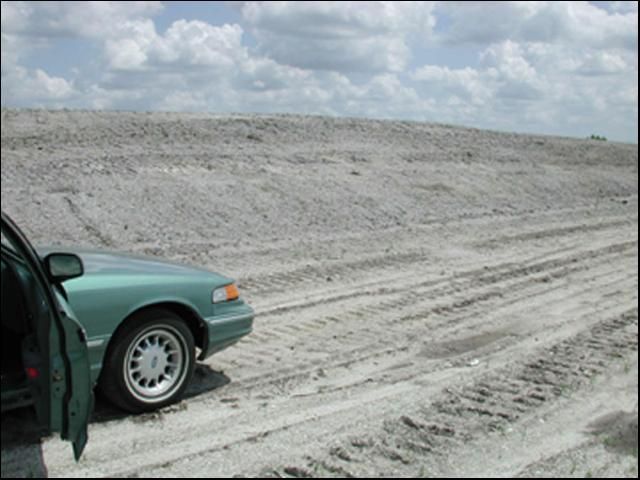
Credit: PCW
Soil Stabilization Practices
A variety of vegetative and nonvegetative slope stabilization methods are available. The following factors should be considered when choosing the soil stabilization methods for your particular situation:
- Potential for damage due to erosion if soils are not stabilized (e.g., pump damage, downstream habitat damage, costs for repair, etc.);
- Velocity of the water flow or wave action;
- Steepness of the ditch bank side slopes;
- Accessibility and practicality for maintaining vegetation at the site;
- Costs for installation and maintenance.
Stabilization with plant ground covers is generally the least expensive method but is only suitable for areas that are not subjected to high flow velocities or turbulence. More expensive, rigid materials are needed in areas with steep slopes and that are subjected to high flow velocities or turbulence.
Stabilization Using Plants
Areas to be planted should be relatively flat (0 to 3:1 slope) if conventional equipment is used for planting and maintenance. When stabilizing erosion-prone areas using vegetation, only species that are adapted to the area where the grove is located should be used. Bare soil surfaces (except directly underneath the tree canopy and tracks within road beds) should be established with appropriate plant species. The vegetation-free herbicide band underneath the tree canopy should not extend beyond the outer edge of the tree canopy. Generally, grassy species should be selected. These species generally have widely branching, dense root masses that hold soil in place. In contrast, broad-leaved plant species generally have fewer roots and do not stabilize soils as well.
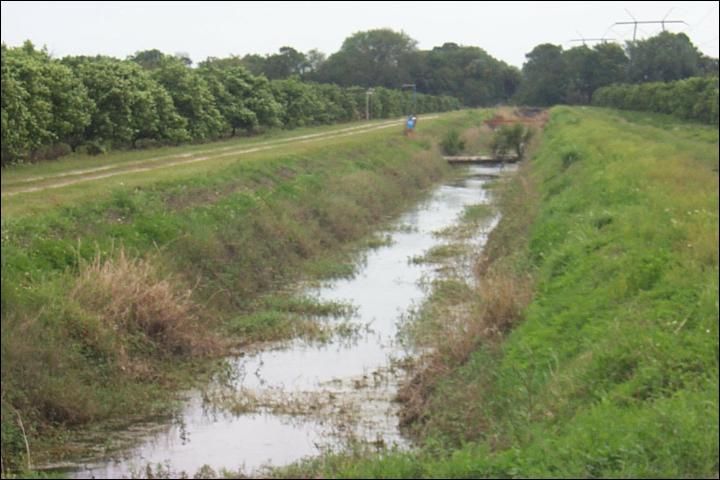
Credit: PCW
Maintenance of vegetative ground covers may be difficult and potentially dangerous in areas with very poor or sandy soils, or unstable or very steep side-banks having a high potential for rollover of tractors and other equipment. Areas such as these may be better stabilized with more durable synthetic or natural materials that require little maintenance.
Considerations for Vegetation Establishment
- Coordinate with plant suppliers before preparing areas to be planted. Depending on the species and season, not all species may be available and installation delays between soil preparation and planting may result in substantial erosion.
- The newly planted site will be especially vulnerable to erosion until the plants have become established. Temporary stabilization barriers should be used as needed to prevent erosion during plant establishment. These barriers may include hay bales, erosion control blankets, temporary seeding, nurse crops, and erosion-control netting.
- When the establishment site is located adjacent to water bodies (i.e., drainage ditches, canals, streams, etc.), measures should be taken to minimize movement of soil into them.
- Apply lime and fertilizers to the planted areas as needed for plant establishment, according to a soil test.
- A suitable seedbed should be prepared, disturbing only the minimum area necessary to do the work.
- If compacted fill is needed before planting, add fill in six-inch layers. Compact each layer by tamping or watering before the next layer is added.
- Sources for more information:
- USDA-NRCS CONSERVATION PRACTICE STANDARD Critical Area Planting Code 342 (https://efotg.sc.egov.usda.gov/references/public/FL/FL342.pdf)
- USDA-NRCS Critical Area Planting Conservation Practice Standard 342 Guidance (https://efotg.sc.egov.usda.gov/references/public/FL/FL342GS.pdf)
- UF/IFAS Extension, Forage Planting and Establishment Methods on Prepared Seedbed, SS-AGR-161 (https://edis.ifas.ufl.edu/ag107)
Selection of Plants for Use in Stabilization
Table 1 lists several species that are recommended by the USDA-NRCS (Code 342GS) for South Florida conditions. Be sure to check with your local UF/IFAS Extension office (http://sfyl.ifas.ufl.edu/find-your-local-office/) or https://edis.ifas.ufl.edu/ for information on varieties that may be better adapted to your conditions. When evaluating the possibility of using plant species other than those listed in Table 1, several characteristics should be considered. Plants should:
- be suited to the soil, site, and climate
- be perennial
- not be invasive outside the planted area
- Consult Florida Exotic Pest Plant Council (www.fleppc.org) for information on invasive plant species
4. have relatively low fertility and low maintenance requirements
Seeded Vegetation
When establishing vegetation by seeding, adequate moisture for germination is needed from irrigation or natural precipitation. Use of scarified and/or hulled seed will enhance germination of some species, which should shorten the establishment period given appropriate growing conditions. Seeding without irrigation requires precise timing to avoid normally dry periods of the year. The NRCS recommends that plants be seeded at least six weeks before the dry seasons begin. For south Florida, recommended dates for planting are 1/15 to 2/28 and 6/1 to 9/15 (Code 342). Consider the following when selecting seed:
- Do not use seed containing prohibited or restricted noxious weeds.
- All seeds should meet Florida Seed Law requirements. Information on seed regulations can be found on the Florida Department of Agriculture and Consumer Services, Division of Agriculture and Environmental Services website, accessible at http://www.leg.state.fl.us/statutes/index.cfm?App_mode=Display_Statute&Search_String=&URL=0500-0599/0578/Sections/0578.09.html
Protection of Seedlings
In some cases, it is necessary to protect young seedlings that are slower growing by planting a nurse crop and/or providing mulch. With nurse crops, the permanent grass seed is mixed with seed of a faster-growing annual species. Establishment of the annual species is rapid, thus protecting soil from erosion in the short term, while the slower-growing perennial species develops. The perennial species should be fully established by the time the annual species dies. If this is not the case, more seed/propagules should be applied to the area. Examples of nurse crops planted between September and February include oats, rye, wheat, and annual ryegrass. Suitable nurse crop species planted between March and August include brown top millet, pearl millet, and Japanese millet (only species adapted for growth in poorly drained soil). Consult NRCS Code 342 for more information on application rates and recommended seed specifications. Use of mulches, either alone or for seedling protection, is described in a later section.
Vegetative Propagules
Establishment of vegetative ground covers using seed may not always be desirable or possible. Grove situations where high erosion potential exists demand rapid development of the ground cover. Some ground cover species can only be established using vegetative propagules because they do not propagate well from seed. Vegetative propagules include stolons, sprigs, and rhizomes. Some areas with high erosion potential may require sod squares or rolls for rapid establishment. Consider the following recommendations (taken from NRCS Code 342) when establishing by vegetative means:
- Use only fresh, moist planting materials. Materials that are not fresh or that have dried out are much less likely to survive.
- Plant material (rhizomes, stolons, crowns, etc.) should be spread over the prepared area uniformly and then be pushed into the top 1–2 inches of soil using a disk harrow with blades set to run straight. After disking the materials into the soil, the planted site should be firmed up using a cultipacker or other type of roller. Plugs should be planted using a mechanized transplanter or hand-planting tools.
- Sprigs should be dug from vigorous stands of plant material. They should be planted when actively growing and adequate moisture is available. NRCS recommended planting dates for south Florida are 6/1 through 9/15.
- Rhizomes must be planted when they are dormant. Heavy mortality will result if the rhizomes are planted after breaking dormancy because of a lack of root reserves.
- Sources for more information:
- USDA-NRCS CONSERVATION PRACTICE STANDARD Critical Area Planting Code 342 (https://efotg.sc.egov.usda.gov/references/public/FL/FL342.pdf)
- USDA-NRCS Critical Area Planting Conservation Practice Standard 342 Guidance (https://efotg.sc.egov.usda.gov/references/public/FL/FL342GS.pdf)
- UF/IFAS Extension, Forage Planting and Establishment Methods on Prepared Seedbed, SS-AGR-161 (https://edis.ifas.ufl.edu/ag107)
Vegetation Maintenance Considerations
Maintenance considerations are important when using plants for soil stabilization. Because most vegetative species will require mowing at some time, areas should be accessible for mowing equipment. Mowing of vegetation on steep slopes requires specialized equipment to lessen the danger of equipment rollover and operator injury. When using herbicides for selective vegetation management, only use those materials that will not harm the soil-stabilizing species. If this is not possible, do not apply the herbicides during the rainy season when erosion potential is greatest. Always consult herbicide labels for species tolerance and use guidelines.
Stabilization Using Mulch-Like Materials
A variety of nonvegetative erosion control materials are available for slope stabilization. Many of these materials may be used in combination with plant materials. These erosion control materials range from dry straw or hay to cellulose fiber mulches and a variety of erosion-control blankets. Other solid materials may also be used. These are considered in the following sections.
Dry Straw or Hay
Dry straw and/or hay provides temporary protection from erosion and is usually used in conjunction with planted materials. These materials should be spread evenly over the area at a rate of 75–90 pounds per 1,000 square feet so that over 75% of the ground surface is covered (NRCS Code 342). These materials are best suited for relatively flat areas. Intact bales of hay or straw should be placed across bare land areas/actively eroding areas where runoff water is channeled to intercept sediment loads.
Cellulose Fiber Mulch
This method of soil stabilization is often referred to as hydroseeding. Cellulose fibers (typically from cane, wood, or recycled newspapers) are mixed with grass seed, fertilizer, and water with this method. The resulting slurry is then sprayed onto ground surfaces using hydraulic seeding equipment. This material has the added advantage that it is self-anchoring because of the cellulose fiber mulch and is suitable for steeper slopes. Liquid fertilizers, limestone suspensions, germination enhancers, moisture retention agents, mulch-binder agents, and a variety of other additives can be applied simultaneously to enhance germination and establishment of the grass. Large areas can be planted in a relatively short period of time using this method.
Jute Matting
Jute matting provides temporary protection from erosion and should be used in conjunction with vegetation establishment from seed. This material is an open mesh, woven, heavy jute twine that has the strength to withstand water flow. It degrades naturally in the environment. Consult matting manufacturers for specific planting instructions. After preparing the seedbed, half of the seed should be sown before the matting is laid down. The other half may then be sown after the matting is laid (NRCS Code 342). The outer edges should be secured to the ground sufficiently to prevent wind or water from lifting the matting. The manufacturer of the matting should also supply the appropriate staples. NRCS recommends placing staples at 5–6 foot intervals on the edges and down the center of each roll (NRCS Code 342).
Bonded Fiber Blanket
Bonded fiber blankets are longer-lived materials, relative to jute matting. Bonded fiber blankets also provide temporary protection from erosion and are used in conjunction with plant establishment. These materials are available in a variety of forms. They typically consist of a plastic mesh netting laminated to one side of a mulch blanket or woven through the mulch blanket. Straw and coconut fiber are the most common mulches commercially offered. Specific blankets are commercially available that are suitable for use on irrigation/drainage ditch and canal side banks, as well as on other steep, erosion-prone slopes. Consult the manufacturer's representative for advice on the appropriate material for specific applications. Materials will vary depending on side-bank slopes and water flow velocities. These blankets are usually unrolled and stapled over a prepared and seeded surface. Follow manufacturer recommendations for installation.
Solid Re-enforcement Materials
Solid re-enforcement materials are often needed in areas subject to very high water flow velocities and on very steep slopes. These materials are more permanent than the other methods and may or may not be used in conjunction with vegetation. These materials (Figures 3–6) can range from poured concrete to rip-rap, broken concrete blocks/materials, bricks, gabions, or other solid materials. If very coarse materials (such as crushed concrete) are used in areas subject to high flow velocities, a relatively impermeable material (e.g., woven landscape fabric, rubber pond/roofing liner, etc.) should be placed underneath to prevent erosion of the underlying soil. Care should be taken when working around such stabilization materials because they may create desirable habitat for a variety of snakes, insects, and other types of wildlife.
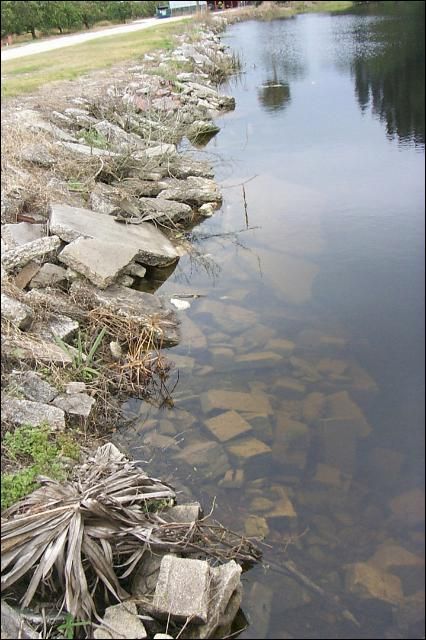
Credit: PCW
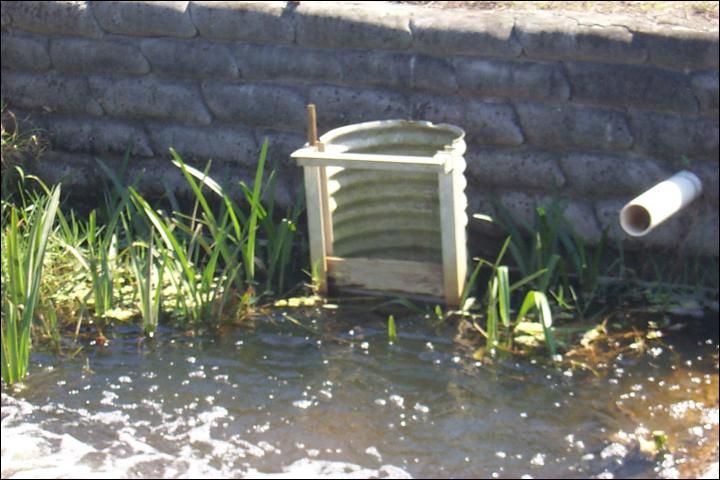
Credit: PCW
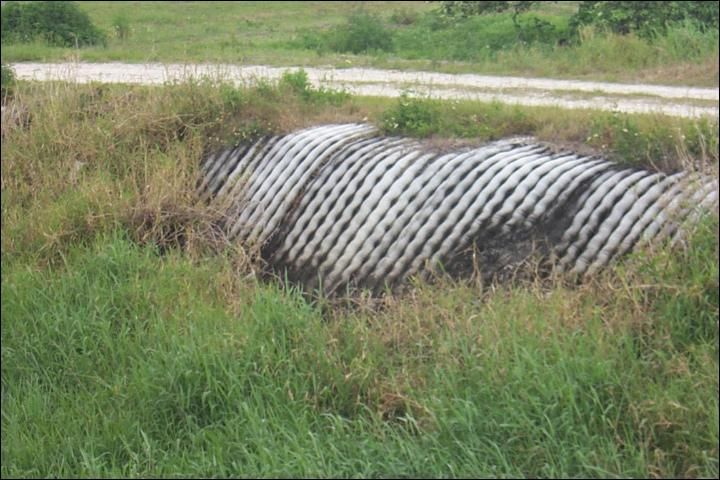
Credit: PCW
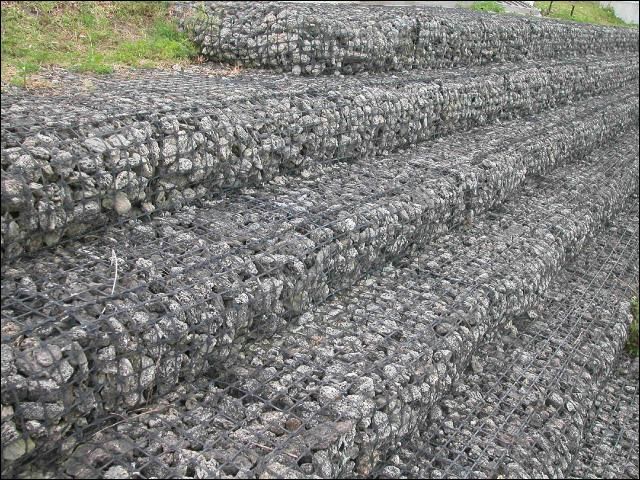
Credit: BJB
References
Florida Seed Law Requirements: http://www.leg.state.fl.us/statutes/index.cfm?App_mode=Display_Statute&Search_String=&URL=0500-0599/0578/Sections/0578.09.html
USDA/NRCS National Engineering Handbook, Section 16, Drainage of Agricultural Land; Chapter 5: Open Ditches for Drainage – Design, Construction, and Maintenance. https://directives.sc.egov.usda.gov/OpenNonWebContent.aspx?content=18366.wba
USDA-NRCS. 2018 (February). CONSERVATION PRACTICE STANDARD Critical Area Planting Code 342 (https://efotg.sc.egov.usda.gov/references/public/FL/FL342.pdf)
USDA-NRCS. 2018 (February). Critical Area Planting Conservation Practice Standard 342 Guidance (https://efotg.sc.egov.usda.gov/references/public/FL/FL342GS.pdf)
Wallau, M. O., J. Vendramini, and Y. C. Newman. 2001. Forage Planting and Establishment Methods on Prepared Seedbed. SS-AGR-161. Gainesville: University of Florida Institute of Food and Agricultural Sciences. https://edis.ifas.ufl.edu/ag107